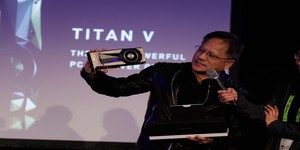Nvidia announces Volta-based Xavier SoC
September 29, 2016 | 09:40

Nvidia is continuing its heavy push into the automotive market with the announcement of Xavier, a Volta-based system-on-chip (SoC) design the company hopes will be driving the autonomous vehicles of the future.
Nvidia first announced that it was serious about making an impact in the automotive sector with the opening of a dedicated technology centre in Michigan in 2013. Two years later the company announced the Tegra X1, a spin of its previously mobile-centric ARM-based system-on-chip (SoC) designs which it claimed would be perfect for running the artificial intelligence system needed of a self-driving car.
Now, the company is once again doubling down on automotive technology with Xavier, a new SoC design featuring an eight-core ARM central processor and a 512-core graphics processor based on the company's new Volta architecture. In short: it promises to be a bit of a beast, at least according to Nvidia's chief executive Jen-Hsun Huang. 'This is the greatest SoC endeavour I have ever known,' Huang told attendees at the company's GPU Technology Conference Europe, where Xavier was unveiled, 'and we have been building chips for a very long time.'
The chip itself, built on a 16nm FinFET process, includes the aforementioned CPU and GPU blocks as well as a visual processor capable of 8K resolution with a high dynamic range (HDR) and a 'computer vision accelerator.' This block, Nvidia explains, works much like the Movidius visual processing unit (VPU) technology recently acquired by rival Intel, and is designed to accelerate tasks revolving around depth-sensing and image recognition from connected camera systems.
As far as power goes, Nvidia claims that a single Xavier SoC is capable of offering 20 TOPS (trillion operations per second, a seemingly different metric than the company's usual measurement of floating-point operations per second) in a 20W power envelope. With that performance, the company claims, manufacturers can replace an existing Nvidia Drive PX 2 in-car computer system and its dual discrete graphics processing units with a single Xavier chip for equal performance at a significantly lower power draw.
Nvidia has indicated that Xavier samples will ship in limited quantities for research purposes at the tail end of 2017, with no firm launch date yet provided for commercial availability and implementation. The remainder of the company's announcement can be found on the official website.
Nvidia first announced that it was serious about making an impact in the automotive sector with the opening of a dedicated technology centre in Michigan in 2013. Two years later the company announced the Tegra X1, a spin of its previously mobile-centric ARM-based system-on-chip (SoC) designs which it claimed would be perfect for running the artificial intelligence system needed of a self-driving car.
Now, the company is once again doubling down on automotive technology with Xavier, a new SoC design featuring an eight-core ARM central processor and a 512-core graphics processor based on the company's new Volta architecture. In short: it promises to be a bit of a beast, at least according to Nvidia's chief executive Jen-Hsun Huang. 'This is the greatest SoC endeavour I have ever known,' Huang told attendees at the company's GPU Technology Conference Europe, where Xavier was unveiled, 'and we have been building chips for a very long time.'
The chip itself, built on a 16nm FinFET process, includes the aforementioned CPU and GPU blocks as well as a visual processor capable of 8K resolution with a high dynamic range (HDR) and a 'computer vision accelerator.' This block, Nvidia explains, works much like the Movidius visual processing unit (VPU) technology recently acquired by rival Intel, and is designed to accelerate tasks revolving around depth-sensing and image recognition from connected camera systems.
As far as power goes, Nvidia claims that a single Xavier SoC is capable of offering 20 TOPS (trillion operations per second, a seemingly different metric than the company's usual measurement of floating-point operations per second) in a 20W power envelope. With that performance, the company claims, manufacturers can replace an existing Nvidia Drive PX 2 in-car computer system and its dual discrete graphics processing units with a single Xavier chip for equal performance at a significantly lower power draw.
Nvidia has indicated that Xavier samples will ship in limited quantities for research purposes at the tail end of 2017, with no firm launch date yet provided for commercial availability and implementation. The remainder of the company's announcement can be found on the official website.

MSI MPG Velox 100R Chassis Review
October 14 2021 | 15:04








Want to comment? Please log in.